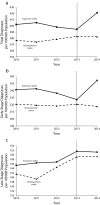Effect of Medicaid Expansions of 2014 on Overall and Early-Stage Cancer Diagnoses
- PMID: 29267058
- PMCID: PMC5846584
- DOI: 10.2105/AJPH.2017.304166
Effect of Medicaid Expansions of 2014 on Overall and Early-Stage Cancer Diagnoses
Abstract
Objectives: To determine whether the 2014 Medicaid expansions facilitated by the Affordable Care Act affected overall and early-stage cancer diagnosis for nonelderly adults.
Methods: We used Surveillance, Epidemiology, and End Results Cancer Registry data from 2010 through 2014 to estimate a difference-in-differences model of cancer diagnosis rates, both overall and by stage, comparing changes in county-level diagnosis rates in US states that expanded Medicaid in 2014 with those that did not expand Medicaid.
Results: Among the 611 counties in this study, Medicaid expansion was associated with an increase in overall cancer diagnoses of 13.8 per 100 000 population (95% confidence interval [CI] = 0.7, 26.9), or 3.4%. Medicaid expansion was also associated with an increase in early-stage diagnoses of 15.4 per 100 000 population (95% CI = 5.4, 25.3), or 6.4%. There was no detectable impact on late-stage diagnoses.
Conclusions: In their first year, the 2014 Medicaid expansions were associated with an increase in cancer diagnosis, particularly at the early stage, in the working-age population. Public Health Implications. Expanding public health insurance may be an avenue for improving cancer detection, which is associated with improved patient outcomes, including reduced mortality.
Figures

References
-
- Health, United States, 2016: With Chartbook on Long-Term Trends in Health. Hyattsville, MD: National Center for Health Statistics; 2017. - PubMed
-
- World Health Organization. Guide to Cancer Early Diagnosis. Geneva, Switzerland: World Health Organization; 2017.
-
- US Department of Health and Human Services. HHS Strategic Plan FY 2014-2018. 2014. Available at: https://www.hhs.gov/about/strategic-plan/index.html. Accessed July 1, 2017.
Publication types
MeSH terms
Grants and funding
LinkOut - more resources
Full Text Sources
Other Literature Sources
Medical

